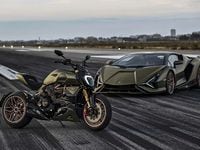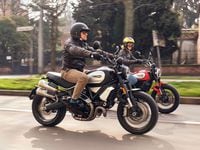I love watching old guys squirm when you call these things bobbers, but in reality I was right there with them a couple of years ago when Indian and Triumph released these models. I got into the motorcycling world through the custom side of things, so it cuts right to my chopperin’ core when we have to call a stock bike a bobber. The term that once referred to a bike “bobbed,” or stripped down from stock, specifically with the front fender removed and used as the rear, now means a minimal, more aggressively styled cruiser. The Triumph Bonneville Bobber Black and the Indian Scout Bobber are low, solo bar hoppers—niche bikes that for all logical reasons should be a tougher sell than their more versatile brethren but have been flying out of dealerships. We wanted to find out why, and pit them against each other to find out which one is worth your hard-earned cash.
These Bobbers are a unique breed of motorcycle built for a unique breed of rider. Both bikes were designed to be expressions of their owner, stylish and ready to be customized to even further display the rider’s personality. They’re both smaller than traditional full-sized cruisers, or Big Twins, but with larger engines carrying more than enough power to get into and out of trouble. They both hold somewhat of a traditional cruiser silhouette, while simultaneously being a departure from the cruiser norm and built for a little different type of riding—more bar hoppers than highway jammers. So which one is better? It depends on what you’re looking for but each has its own set of distinct advantages.
From a stock styling and aesthetics point of view, the Triumph takes the cake. Its tubular chassis with mock-hardtail line, slim gas tank in that iconic Triumph shape, mock Amal carbs, and floating solo seat hearken back to the early days of bobberdom. They actually nailed the bobber thing and Triumphs were one of the chosen platforms of the day, so it’s very befitting. While the Scout’s load-bearing engine and cast frame panels function very well in terms of weight and rigidity, those large pieces aren’t very nice to look at and are damn hard to hide. When it comes to customization, however, the Scout would be the more obvious choice due to the much wider range of aftermarket parts and accessories. Triumph makes more than 130 accessories for its Bobber, but it’s hard to compete with the American V-twin aftermarket.
When it comes to handling, neither of these bikes were built to shred the twisties, but that doesn’t mean they can’t take a turn with some haste. The low ground clearance associated with the Bobber name meant we were scraping pegs around most corners, but the chassis of the Bonneville Bobber gave it a couple of distinct advantages. With a wheelbase of 59 inches, it’s 2.5 inches shorter than the Scout, and the rake is substantially steeper (25.4 degrees on the Triumph, 29 degrees on the Indian), which translates to more responsive low-speed handling and less resistance when dropping into turns. But the biggest difference in handling comes from the tires. Indian uses these high-profile Kenda K761, chunky tread-patterned tires that look great but sacrifice performance to do so. The Avon Cobra tires on the Triumph make a huge difference in how smooth the bike rides on the road, how well it grips the road, and how it handles input.
Despite their differences in configuration, the engines on these two bikes actually have somewhat similar characteristics. For one, they both like to do burnouts—a lot. On paper, the Scout would trump the Bonnie, but we found different results once we tested the bikes on our in-house dynamometer. While the Scout had a claimed 100 hp and 72 pound-feet of torque, we found it actually delivered 81.95 hp and 62.82 pound-feet to the wheel. The Triumph claims 76 hp and 78 pound-feet of torque, and came in at a much closer 73.32 hp and 75.02 pound-feet. While riding the bikes, it feels exactly like you’d expect from those numbers—the Triumph has more to offer at the drop of the clutch, but the Indian winds up better and has a little more to give in the higher revs.
The dual front discs and Brembo calipers on the Bobber Black were very responsive and worked well, but the front suspension had a hefty dive under hard braking, even with the new Showa suspension. The single disc on the Scout Bobber was plenty adequate, and the suspension held up better under the same circumstances. Ergonomically, the bikes are pretty similar with their low seat heights, solo seats, and low bars, but the Triumph’s mid-controls earned my preference. The Bonneville’s seat is adjustable, but I found anything other than the stock positioning a little awkward for me. Both bikes are equipped with only a solo seat and no passenger options, but the Indian’s seat has much more padding and I was able to ride a bit longer on the Scout before getting saddle sore.
While a certain amount of the long-distance comforts are expected to be trimmed away with the bobber transformation, the Triumph’s blend of a thirsty big motor and small 2.4-gallon gas tank makes stops a little too frequent for my liking. Given, I was twisting that throttle like it owed me money, but my intervals between stops on the Scout were much larger, even when riding with the same reckless abandon.
Both bikes have great engines, good chassis, and decent suspension. The ergonomics on the Triumph were preferential for short distances, but the hard seat had me leaning toward the Scout for anything longer than about 20 minutes. The Bonnie’s styling, in my opinion, is much better, but the Indian’s versatility in the aftermarket balances that out. The Scout’s ability to stay on the road longer, due to both its more comfortable seat and larger gas tank, was a huge advantage. The Scout comes in about $1,600 cheaper than the Bonnie, but that’s because we were testing the Bobber Black model, with cruise control, better suspension, dual front discs, and other upgraded components—the base-model Bobber is only $400 more than the Scout and a bit more similar.
With all things considered, the choice falls back on the balance of style and performance. If you want a bike that has the real iconic bobber style, the Triumph is the more obvious choice. But when it comes to the ride, you get more bike for your buck with the Indian Scout Bobber.











/cloudfront-us-east-1.images.arcpublishing.com/octane/MY6PCYTKM5AZBPW4HQ4UR3OCOI.jpg)
/cloudfront-us-east-1.images.arcpublishing.com/octane/RBBHN6ALAJAMBHSR2FHNNA4SGQ.jpg)
/cloudfront-us-east-1.images.arcpublishing.com/octane/BICE3TTIVNCAFK5LY7XNTKBJJM.jpg)
/cloudfront-us-east-1.images.arcpublishing.com/octane/M3L6UDNVBFHOHGPNQMCMI4XC7U.jpg)
/cloudfront-us-east-1.images.arcpublishing.com/octane/MKXVW7IGMVDG7JW36WDMCFEDBE.jpg)
/cloudfront-us-east-1.images.arcpublishing.com/octane/RPQJWG3JZNHJ7BUDSI5OFAUTTA.jpg)
/cloudfront-us-east-1.images.arcpublishing.com/octane/XNVY3EVWZFCEVPUGJGAN633LXE.jpg)
/cloudfront-us-east-1.images.arcpublishing.com/octane/2PLTVHXY7FDSPFHKU5CFOC43ZY.jpg)
/cloudfront-us-east-1.images.arcpublishing.com/octane/B6M3WTRLFZGNXBEATNXPVGBBD4.jpg)
/cloudfront-us-east-1.images.arcpublishing.com/octane/4CMH3FI73BEM5D6MFYX42FLDSQ.jpg)
/cloudfront-us-east-1.images.arcpublishing.com/octane/RIHAPYNWU5H3XAOXNOPRWCBTQA.jpg)
/cloudfront-us-east-1.images.arcpublishing.com/octane/HU4NUBCL3VAFZA75VYRCMAUHVM.jpg)
/cloudfront-us-east-1.images.arcpublishing.com/octane/OB43AZK7TRA6XLZL5WRDVW2TDA.jpg)
/cloudfront-us-east-1.images.arcpublishing.com/octane/5G44Y3FXWNFSTEQKCA355PXOPU.jpg)

/cloudfront-us-east-1.images.arcpublishing.com/octane/XRI4GTLCVBA5NESASCBIR5LYQI.jpg)
/cloudfront-us-east-1.images.arcpublishing.com/octane/EF7566PXARGMBAOMLWTECYL3LE.jpg)





/cloudfront-us-east-1.images.arcpublishing.com/octane/3LASNXSWUZFFPISURDJF3OCWBU.jpg)
/cloudfront-us-east-1.images.arcpublishing.com/octane/2BHJKWUTBNBTLMQCKDNVEG6DKQ.jpg)
/cloudfront-us-east-1.images.arcpublishing.com/octane/MPHXIIV54NAU5L6E4SYZHCXVRM.jpg)



/cloudfront-us-east-1.images.arcpublishing.com/octane/WYXFHF4ZOBBTXELIZDB2FJXU64.jpg)
/cloudfront-us-east-1.images.arcpublishing.com/octane/K5FNV7ONUVDXJJ2H5BIWUGBGTI.jpg)